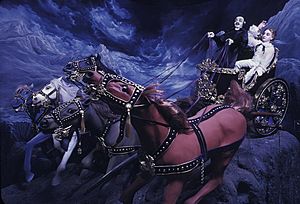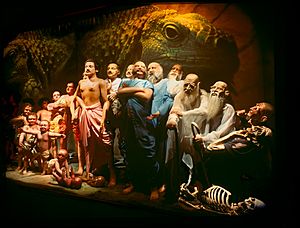Bhagavad-gita Museum facts for kids
| Established | 1977 |
|---|---|
| Location | 3764 Watseka Ave., Los Angeles, California |
| Type | Art museum |
| Owner | International Society for Krishna Consciousness |
The Bhagavad-gita Museum is a special art museum in West Los Angeles, California. It is also known by its official name, the Diorama-museum of Bhagavad-gita, or its nickname, the First American Transcendental Exhibition (FATE). This museum uses multimedia to show the ideas and teachings from the Bhagavad-gita, an important ancient text.
The museum first opened in 1977. It is owned and run by the International Society for Krishna Consciousness (ISKCON). This group is also known as the Hare Krishna movement.
Contents
History of the Museum
The idea for the Bhagavad-gita Museum came from an older exhibit. This exhibit was created by Bhaktisiddhanta Sarasvati in the 1930s. It had many dioramas that showed the ideas of Krishna consciousness.
In 1973, one of Sarasvati's students, A. C. Bhaktivedanta Swami Prabhupada, wanted to create a similar museum. Prabhupada was the person who started the International Society for Krishna Consciousness (ISKCON). He sent a group of his students from New York to Mayapur, India. There, they learned how to make diorama dolls.
After about 15 months of learning, the team came back. They started making the dolls in Los Angeles. The museum finally opened its doors in 1977. It is located in West Los Angeles, close to Culver City. Many Hare Krishna followers live in this area.
Technology and Upgrades
When it first opened, the museum was very advanced for its time. A special computer was built to control the exhibit. This computer made sure that the lights, sounds, and special effects all worked together. It used a 16-track sound system and many film and slide projectors.
In 1984, the museum got new, stronger projectors and better lighting. However, all this fancy technology sometimes caused problems. The exhibit had computer issues and needed a lot of repairs. By 1995, it was in bad shape.
Starting in 1999, the museum began to be fixed up. It reopened in 2001 with modern electronic controls. More improvements were made in the 2010s. The museum was fully reopened again in 2016, ready for visitors.
What You Can See: Exhibits
The museum has eleven different dioramas. These are like 3D scenes with almost life-sized dolls. The dolls are made from traditional Indian materials. These include bamboo, rice straw, different types of clay, and rice husk. They are made using old-fashioned building and decorating methods. Even though the museum has been updated, the dioramas themselves keep their traditional look.
Here are the names of the dioramas you can see:
- "Introduction — Prabhupada and the Bhagavad-gita"
- "Setting the Stage"
- "Changing Bodies"
- "The Precarious Condition of the Living Entity"
- "Choices on the Path of Life"
- "Equal Vision of the Sages"
- "Krishna's Transcendental Manifestations"
- "God's Universal Form"
- "The Ocean of Birth and Death"
- "Lord Chaitanya's Sankirtan Festival"
- "Goloka — The Spiritual Realm"
Other Things to Do at the Museum
Next to the museum, there is a restaurant. It serves delicious vegetarian food. The museum also has a gift shop where you can find souvenirs and other items.



